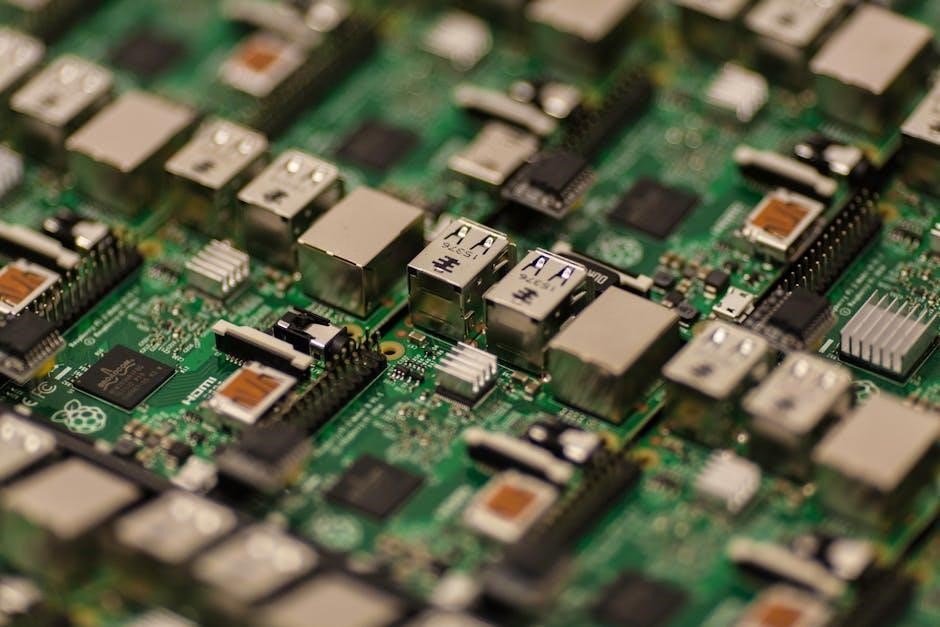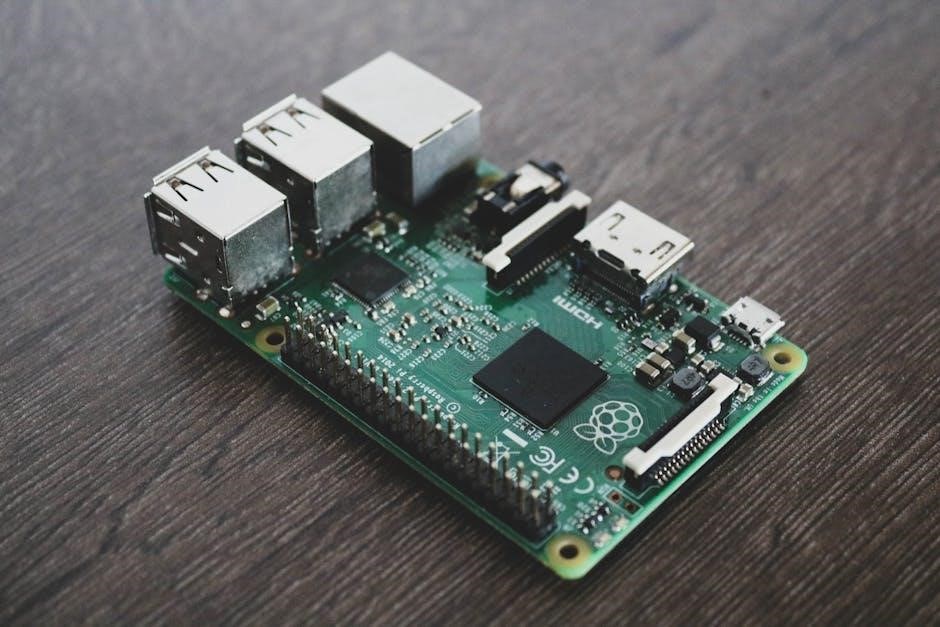Embedded Linux is crucial for developing versatile and robust embedded solutions. The book Mastering Embedded Linux Programming serves as a comprehensive guide, covering toolchains, bootloaders, kernel configuration, and root filesystems.
Overview of Embedded Linux and Its Importance
Embedded Linux is a cornerstone of modern embedded systems, powering devices from consumer electronics to industrial control systems. Its open-source nature fosters innovation, reduces costs, and enables customization. The Mastering Embedded Linux Programming book highlights its versatility, scalability, and reliability. Embedded Linux bridges hardware and applications, allowing developers to create high-performance, secure solutions. Its widespread adoption underscores its critical role in shaping the future of embedded technologies, making it essential for engineers and developers to master.
Key Features of the Book “Mastering Embedded Linux Programming”
The book provides a comprehensive guide to embedded Linux development, focusing on toolchains, bootloaders, kernel customization, and root filesystems. It covers debugging and profiling techniques for both user space and kernel modules. The third edition introduces Linux 5.4 and Yocto Project 3.1, offering practical examples and troubleshooting tips; Written for systems engineers and administrators, it serves as both a learning resource and a reference, ensuring readers gain hands-on expertise in building robust embedded systems.

Setting Up the Development Environment
Setting up a development environment involves installing toolchains, cross-compiling tools, and build systems like Buildroot and Yocto. Proper configuration ensures efficient embedded Linux development.
Toolchains and Cross-Compiling
Toolchains are essential for embedded Linux development, enabling cross-compiling for target architectures. They include GCC, Binutils, and GDB. The book guides setting up and using these tools effectively, ensuring compatibility and optimal performance for embedded systems, leveraging Linux 5.4 and Yocto Project 3.1.
Installing and Configuring Build Tools
Build tools like Buildroot and the Yocto Project simplify the creation of custom Linux systems for embedded devices. These tools automate the process of configuring and compiling the kernel, device tree, and root filesystem. The book guides readers in installing and configuring these tools, ensuring proper cross-compilation and dependency management. This enables developers to focus on system optimization and customization rather than tedious manual configurations, streamlining the development workflow for embedded Linux solutions.
Understanding the Boot Process
Embedded Linux systems rely on bootloaders to initialize hardware and load the kernel. The boot process involves U-Boot, kernel initialization, and transitioning to user space seamlessly.
The Role of Bootloaders in Embedded Linux
Bootloaders are essential for initializing hardware and loading the Linux kernel into memory. They act as the bridge between the hardware and the operating system, ensuring a smooth boot process. U-Boot is a commonly used bootloader in embedded systems, offering flexibility and customization. It handles hardware initialization, loads the kernel, and transitions control to the operating system. Proper configuration and management of bootloaders are critical for reliable embedded Linux systems, as they ensure the system boots correctly and efficiently every time.
Configuring U-Boot for Embedded Devices
Configuring U-Boot is pivotal for tailoring boot behavior in embedded Linux systems. It involves setting environment variables, defining boot scripts, and optimizing device-specific parameters. U-Boot supports features like network booting and device tree integration, enabling flexible system initialization. Proper configuration ensures reliable hardware initialization and efficient kernel loading. Advanced options, such as secure boot and splash screens, can also be implemented to enhance system security and user experience. This process is detailed in the Mastering Embedded Linux Programming guide, providing hands-on examples for effective U-Boot customization.

Working with the Linux Kernel
Working with the Linux kernel involves customization, device tree configuration, and debugging. These techniques optimize performance and ensure compatibility with embedded systems effectively.
Customizing the Linux Kernel for Embedded Systems
Customizing the Linux kernel is essential for tailoring embedded systems to specific requirements. This involves optimizing performance, reducing footprint, and enabling hardware support. By configuring kernel modules and device drivers, developers can enhance functionality while ensuring efficient resource utilization. Mastering Embedded Linux Programming provides detailed guidance on kernel customization, including device tree configuration and debugging techniques. These practices ensure robust, reliable, and high-performance embedded Linux solutions.
Device Tree Configuration and Management
Device Tree configuration is vital for describing hardware components to the Linux kernel. It abstracts hardware details, enabling the kernel to communicate effectively with embedded systems. Managing Device Trees involves editing and compiling Device Tree Source (DTS) files to ensure hardware independence. Mastering Embedded Linux Programming provides practical examples and debugging tips, helping developers maintain consistent configurations across different embedded devices. This ensures seamless hardware-software interaction and optimal system performance.

Building and Customizing Root Filesystems
Building and customizing root filesystems is essential for tailored embedded Linux solutions; Tools like Buildroot and the Yocto Project simplify filesystem creation and optimization for specific hardware needs.
Using Buildroot and Yocto Project for Filesystem Creation
Buildroot and the Yocto Project are powerful tools for creating and customizing embedded Linux filesystems. Buildroot simplifies the process with minimal configuration, while Yocto offers flexibility and scalability. Both tools support package management, enabling developers to optimize filesystems for resource-constrained devices. They streamline the integration of libraries, applications, and kernel modules, ensuring tailored solutions for specific hardware requirements. These tools are widely adopted in embedded Linux development for their efficiency and adaptability.
Optimizing Filesystems for Resource-Constrained Devices
For devices with limited resources, optimizing filesystems is critical. Techniques include minimizing storage usage by removing unnecessary packages and leveraging compressed filesystems. Tools like Buildroot and the Yocto Project allow for tailored configurations, ensuring only essential components are included. Additionally, optimizing boot times and reducing memory footprint can significantly enhance performance. These methods ensure efficient operation on resource-constrained embedded systems, making them ideal for low-power applications.

Debugging and Profiling Techniques
Mastering debugging and profiling is essential for identifying and resolving issues in embedded Linux systems, ensuring optimal performance and reliability.
Debugging User Space Applications
Debugging user space applications in embedded Linux involves identifying and resolving issues in applications running on top of the kernel. Tools like GDB and logging mechanisms are essential for troubleshooting. The book emphasizes practical approaches to debug applications, ensuring reliability and performance. It also covers tracing system calls to identify bottlenecks, helping developers optimize their code effectively. These techniques are crucial for maintaining robust embedded systems, as outlined in Mastering Embedded Linux Programming.
Kernel Debugging and Profiling Tools
Kernel debugging and profiling are essential for optimizing embedded Linux systems. Tools like GDB and kernel-level tracers help identify and fix issues within the kernel. Profiling tools analyze performance metrics, revealing bottlenecks and areas for improvement. These techniques ensure a stable and efficient kernel, crucial for embedded systems. The book provides detailed guidance on utilizing these tools effectively, enhancing overall system reliability and performance.

Advanced Topics and Best Practices
Explore secure embedded Linux solutions and compare agile vs. traditional software engineering. The book offers a comprehensive approach, serving as both a learning tool and detailed reference.
Implementing Secure Embedded Linux Solutions
Securing embedded Linux systems is critical for protecting sensitive data and ensuring reliable operation. The book emphasizes the importance of secure coding practices, authentication mechanisms, and robust system hardening. It explores the use of open-source tools and frameworks to implement security features like secure boot, encryption, and access control. By following best practices and leveraging Linux’s built-in security capabilities, developers can create resilient embedded systems that withstand potential threats and vulnerabilities in real-world applications.
Agile vs. Traditional Software Engineering in Embedded Systems
Embedded Linux development often involves choosing between agile and traditional software engineering methodologies. Agile practices, with their iterative approach and rapid feedback, are ideal for dynamic projects requiring flexibility. Traditional methods, emphasizing detailed planning and linear execution, suit well-defined, resource-constrained systems. The book highlights the benefits of combining both approaches, leveraging agility for innovation while maintaining the reliability of traditional practices, ensuring efficient and robust embedded system development tailored to specific project needs and timelines.

Real-World Applications and Case Studies
Embedded Linux powers high-performance systems across industries, from consumer devices to industrial automation. Case studies highlight efficient deployment and customization, showcasing Linux’s versatility in real-world applications.
Developing High-Performance Embedded Systems
Embedded Linux enables the creation of high-performance systems by optimizing kernel configurations and leveraging tools like Yocto and Buildroot. The book provides detailed insights into maximizing system efficiency, ensuring reliability, and scaling for complex applications. Case studies illustrate how Linux-based systems excel in industrial automation, consumer electronics, and IoT devices, showcasing their adaptability and power. These real-world examples highlight Linux’s role in driving innovation and meeting stringent performance requirements in embedded environments.
Lessons Learned from Real-World Embedded Linux Projects
Real-world embedded Linux projects reveal valuable lessons in optimizing performance and reliability. The book shares insights from actual implementations, highlighting best practices for using Yocto and Buildroot. Common challenges, such as debugging and resource constraints, are addressed with practical solutions. By understanding hardware-software interactions and leveraging advanced configuration techniques, developers can overcome obstacles and deliver successful embedded systems. These case studies provide a roadmap for navigating complex embedded Linux environments effectively.





